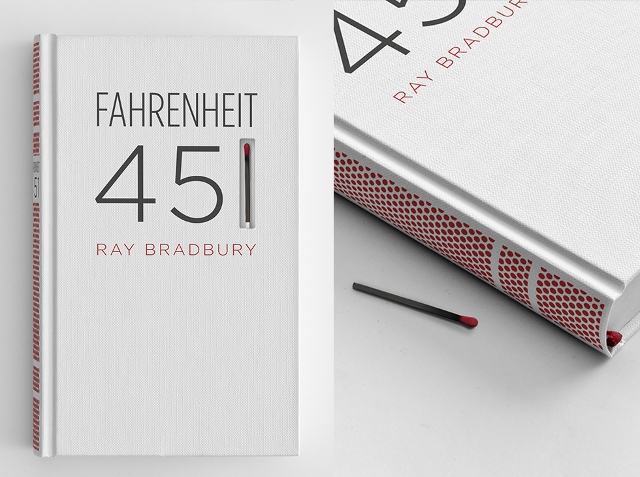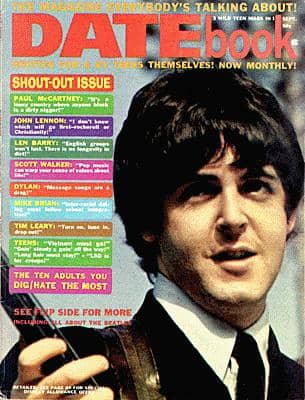
I recently watched HBO’s remake of Ray Bradbury’s Fahrenheit 451 starring Michael Jordan and Michael Shannon. The film got me thinking about our political climate today and the suppression of ideas that do not coincide with the company line. It made me think about how close we are to this incendiary topic becoming a reality.
Fahrenheit 451 was written in the early 1950s during the McCarthy witch hunts, a point in time when the author feared America reached a point where the burning of ‘subversive’ literature was more than a slight possibility. The book focuses on an American society in the near future where owning a book is a crime. ‘Firemen’ are employed to burn any books found.
When I came across the book cover of the edition pictured above, I thought how simple, yet powerfully effective it was. The title with the ‘1’ replaced by a matchstick. That one degree, stressing the point where paper burns.
Book burning or other materials has a history going a long way back to before Christ. In America, the first book burning occurred during the War of 1812, when the British, not the Canadians, in 1814 burned down the U.S. Capital and other facilities of the Government including most of the 3,000 books housed in the Library of Congress.
In 1935, Government officials of Warsaw, Indiana where author Theodore Dreiser (An American Tragedy, Sister Carrie) was born and attended high school, demanded that all library copies of Dreiser’s inflammatory books be burned.
After World War II, with the defeat of Germany and the Japanese, some Americans needed to find a new battle. A German-born psychiatrist named Fredric Wertham who treated delinquent children discovered during his hospital work in Harlem that most of these troubled kids he worked with read comic books. He came up with his own formula equating kids times comic books = juvenile delinquency. By 1948, Wertham was on a crusade attacking comic books in some very prestigious magazines. His attacks on the comic book industry continued for years including presenting himself to the 1954 U.S. Senate Subcommittee Hearing on Juvenile Delinquency wherein part he stated, “I think Hitler was a beginner compared to the comic-book industry.” Pressure was put on comic book publishers to stem the tide of this dreaded menace. Parental concerns mounted. On October 26, 1948, in the town of Spencer, West Virginia, religious leaders, teachers, and parents oversaw the collection and burning of hundreds and hundreds of evil comic books. It wasn’t just the South that was in an uproar. Shortly after that Binghamton, New York, conducted their own public barn book fire. Considering the publicity by the news media, other cities followed, including Rumson, New Jersey, Cape Girardeau, Missouri, and Chicago. The fever even spread across to the Canadian border when a group called the JayCee Youth Leadership collected and burned over 8,000 comic books. It was in this heated climate that Ray Bradbury wrote his dystopian classic, Fahrenheit 451.

For baby-boomers, the most famous book burning was the 1966 Beatles controversy. Religious conservatives in the South’s Bible Belt were up in arms after John Lennon’s quote “we are more popular than Jesus” was taken out of context from an interview with journalist Maureen Cleave that originally appeared in London’s Evening Standard some five months earlier. When the U.S. teen magazine Datebook published the interview, Lennon’s quote “I don’t know which will go first–Rock ‘n’ Roll or Christianity!” was on the front cover. In Birmingham, Alabama, always a hotbed of progressive thinking. DJ’s banned the playing of Beatles records. As the British rock group’s tour in the U.S. began protests rocked all over the South, Beatles records, magazines and books were tossed into large piles by fired up parents and teens and burned.
Most recently (2006) J. K. Rowling’s Harry Potter books attracted attention because of claims that the magic in the Potter book series struck a strong resemblance to practices of the occult. Incidents of Potter book burning occurred in Alamogordo, New Mexico, and Charlotte, South Carolina. Protestant, Catholic and mostly from Evangelical Christian groups flamed the claims.
Like other classic novels, The Handmaid’s Tale, 1984, Brave New World and It Can’t Happen Here, Fahrenheit 451 is a novel about suppression, control of people and ideas. With the political climate we face today it seemed to be a timely move by HBO to remake Bradbury’s novel into a movie. The film stars Michael B. Jordan as Montag, a rising star in the ranks of ‘fireman’ who starts to develop doubts about the mission of suppressing books after meeting a rebelling young woman. Michael Shannon is Captain Beatty. In the world of the future, people need not bother themselves with unpleasant thoughts or feelings. Books are the culprit. They bring up depressing subject matter, sadness and most frightening to the government, independent thinking. Subsequently, the government sanctions drugs, emotionally free relationships and numbing mass media. Those who disobey are eliminated.
While Jordan and Michael Shannon as Captain Beatty are very good, the film, though not bad, is a disappointment. An even bigger disappointment when compared to Francois Truffaut’s 1966 film which though it moves at a slower pace definitely captures the feel and beliefs behind Bradbury totalitarian tale.

Terrific post John. I was reared to be respectful of other peoples political views, that politics was largely a private affair. These days I respect those, like yourself, who speak out. Thank you for your service–then and now.
LikeLiked by 1 person
Reblogged this on John Greco Author/Photographer.
LikeLike